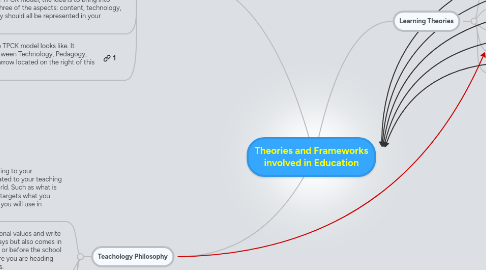
1. TPCK
1.1. There are three area of nowledge that are associated with the TPCK model.
1.1.1. 1) Content: which is what you have to teach on a particluar subject.
1.1.2. 2) Pedagogy: which is your philosophy of your teaching methods.
1.1.3. 3) Technology: which is the different tools in our wrld that we can use to enhance our teaching and students experience.
1.2. With regards to the TPCK model, the idea is to bring into your teachings all three of the aspects: content, technology, and pedagogy. They should all be represented in your lesson.
1.3. I found a link as to what the TPCK model looks like. It shows the relationships between Technology, Pedagogy, and Content. (click on the arrow located on the right of this box).
2. Learning Theories
2.1. Behaviorism
2.1.1. Key Points
2.1.1.1. 1) The use of "Positive Reinforcment", which helps incraese the likelihood of a particular "good" behavior of happening again.
2.1.1.2. 2) The use of "Negative Reinforcment", which is aimed the decreasing the likelihood of a particular unwanted bahevior from happening again.
2.1.1.3. 3) Punishments are not the same as negative reinforcements, it is erasing an unwanted stimuli by presenting a distressing stimuli to curb behaviour.
2.1.1.4. Suggestions for Education:When creating your classroom environment the best way to help shape the unwanted behaviour or wanted behaviour is to have a well structured rule system that doesn't change through the year. Also by developing a good reinforcement system, either being positive ir negative, or rewarding or punishments, that the students can understand and follow. When dealing with behaviour make sure you have dealt with it in the now(present) and not leave til a later time, before making your decision.
2.2. Cognitivism
2.2.1. Key Points
2.2.1.1. 1) Somewhat similar to that of the behaviorism theory, this theory beleives that there is a cognitive slate, and that hinking in not simply a behaviour.
2.2.1.2. 2) Thinking is somewhat similar to a scaffolding structure or schema. Once you have learned information it remains until you build on the concepts of that knowldge to create a higher structure. Example: math problems you start easy like 2 x 2= 4, then 2 x 11=22, slowly building on higher order thinking.
2.2.1.3. Suggestions for Education:Connect information being presented to past knowldge that the students has already starting building with before junping into something too hard and they have no way of retrieving the information already stored.
2.3. Cognitive Lodaing Theory
2.3.1. Key Points
2.3.1.1. 1) The mind has limited storage capacity with information being presented/learned. Imformation is then transferred to long term memory for future use.
2.3.1.2. 2) Having background information on the subject will greatly assist you with the information being presented at one time. For instances, the mind can only comprehend 7 disconnected items at one time.
2.3.1.3. 3) Only infromation that the learned deams important
2.3.1.4. Suggestions for Education: To help with the infromation being presented to the stduents having images/ diagrams/ or drawings of the concepts that you want the students to learn. Example- in structural anatomy having a map of the muscle system and bones for reference points when studying.
2.4. Connectivism
2.4.1. Key Points
2.4.1.1. 1) Trying to see/ relate/ and connect between ideas and concepts as a core skill.
2.4.1.2. 2) Being able to be up-to-date and be accurate by staying current with the wirld and the world of information.
2.4.1.3. 3) Being able to have the knowldge of where to find the information needed rather than just knowing the information.
2.4.1.4. Suggestions for Education: By allowing the students to network with experts in their fields or of a particular subject of study. Also allowing the students the choice of what they should be learning in a particular area of subject and then have them find that information through a variety of searches or again networking with other may in that area of interest. Example: schools are now connecting with experts in the fields of ecolgy for science classes and having virtual touring of areas that the studenst may not be able to go for field trips, such as, the bad lands. This is what a school in Edmonton did for a grade 6 science class.
2.5. Constructivism
2.5.1. Key Points
2.5.1.1. 1) Learning is built from a foundation of previously leanred knowldge.
2.5.1.2. 2) Personal experiences will affect how one learns the information being taught to them.
2.5.1.3. 3) There has to be a level of metacogntion in order to monitor and direct self-learning and performance.
2.5.1.4. Suggestions for Education: A great way to target this thoery in edcation is group work where everyone brings into the discussion or group their own perspective on the subject and be able to hear the thoughts of other, which incraeses their knowldge base from another persons view.
